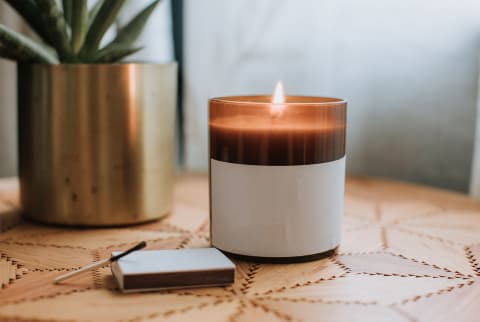Advertisement
Don't Make This Mistake When Burning A New Candle For The First Time


Sliding the lid off a new candle is one of winter's great pleasures. And while it can be tempting to get that sucker burning right away, there are a few things you'll want to consider before lighting yours for the first time.
It turns out, a candle's first burn is the most important for dictating how long it will last, so we asked industry insiders about how to light up new candles like an old pro.
The right way to burn a candle for the first time
When lighting a candle, you'll want to make sure that you leave it burning for long enough that the top layer of wax melts completely, from edge to edge. This ensures that no unburned wax gets left behind and goes to waste. Jon Bresler, the founder and president of LAFCO New York, explains that this is a good thing to do every single time you light a candle—but especially during that all-important initial burn.
"Depending on the amount of soy and how much natural fragrance is in the candle, this initial burn could take several hours," Bresler tells mbg.
Cartter Stout, the creative manager at Paddywax, adds that a good rule of thumb is that you should burn your candle for one hour per inch of diameter. If your candle is 3 inches across, for example, you'll want to leave it burning for around three hours that first time. (Shy away from single-wick candles that are more than 4 inches in diameter, as you don't want to leave a candle burning for more than four hours at a time.)
This means that if you're strapped for time—say, you're about to go to bed or head out for the day—you'd be better off waiting to light that first match until you have a longer window to sit with your new candle.
After that first burn, says Bresler, "the more constantly you burn the candle and allow it to develop a fully melted top layer, the better it will perform and prevent tunneling."
Other tips to ensure an even, clean burn:
- Cut the wick short: "Wick trimming helps your candle have a cleaner, brighter, and longer burn," says Stout. "This practice helps keep the flame in control and prevents smoke stains from forming on the vessel." After the first burn, trim your wick down to around ¼ inch before lighting it again.
- Keep it clean: When you go to cut your wick, Stout adds that you'll want to check the top layer of the wax for ashes and match parts. Remove any of this debris to avoid the flame surging and fire hazards, she suggests.
- Shield it from moving air: Nothing can dampen your flame like a gust of wind or a rush of air conditioning, so Bresler suggests keeping candles away from drafty spots at home. This includes open windows, radiators, or areas that people walk through often. Exposing your candle to moving air can disrupt its flame and lead to soot and vessel staining, he explains.
- Use a candle snuffer: While most of us are used to blowing out our candles birthday cake style, Stout says that doing so can leave lots of soot and ash behind. "We recommend using a candle snuffer to extinguish your candle and avoid wax splattering. If you don't have a snuffer, using the candle's lid is a great alternative and smothers the flame without debris spreading," she says.
- Don't burn for more than four hours: Not only could leaving a wick burning for too long hinder air quality, but it could also cut your candle's lifespan short. Once your wick overheats, it will burn off more wax than needed, leaving you with an uneven candle. He says that the ideal burn time is usually three to four hours, followed by a 24-hour cooldown period.
The takeaway
The next time you get a new candle, be patient and wait until you have a three- to four-hour window to keep it lit at first. This will set the stage for a more even burn, though if you do find yourself with wasted wax, we have some tips.